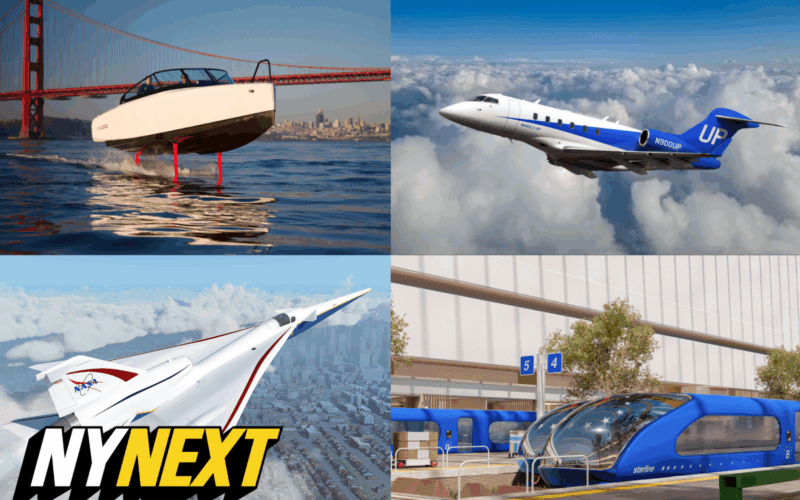Set in 2062, “The Jetsons” predicted a future of flying cars and three-day, three-hour workweeks.
In the coming years, we’ll at least get the cars — in the form of small helicopter-plane hybrids that could make commuting a breeze.
The flying vessels are just one of several exciting new ways of travel on the horizon.
“The future of transit [is] optimistic and ambitious,” Johanna Fabrin — co-founder of 21st Europe, the think tank behind a proposed high-speed rail network linking major cities across the continent — told NYNext.
Have a look at what the future holds for getting around.
Flying taxis transform cities
In June 2025, Vermont-based BETA Technologies completed the first-ever North American passenger flight of an electric-powered plane with its ALIA aircraft. The sleek vessel seats five and is designed to be able to take off both vertically — like a helicopter — and horizontally — like a plane.
Passenger flights are expected within the next year, and commercial service will follow soon thereafter — making quiet, zero-emission air travel as routine as hailing an Uber.
“This really has all the legs to be a meaningful mode of transport for New Yorkers,” BETA CEO Kyle Clark told NYNext.
ALIA is part of a crowded airspace of next-gen companies — among them Joby Aviation, Archer Aviation, Lilium, and Vertical Aerospace — all racing to produce silent, zero-emission “air taxis” at scale.
Joby, one of the furthest along, plans to launch commercial flights with Delta Air Lines in the next several years — shuttling passengers between airports and city centers like JFK and Manhattan in minutes.
Ferries rise above it all
In Scandinavia, energy-efficient electric hydrofoil ferries that hover just above the water have have been whisking commuters across bodies of water for years. Come 2026, expect to see them skimming atop Lake Tahoe, which is nestled between California and Nevada, too.
“Intuitively, it looks like a bad idea,” Gustav Hasselskog, CEO of Candela, a leading manufacturer of hydrofoiling electric boats and ferries, told NYNext. But it isn’t.
Instead of plowing through the water, craft like those manufactured by Candela and its main competitor, Regent, generate lift with hydrofoils — underwater wings not dissimilar to those of a plane.
With only those slim foils touching the water, drag drops by close to 80%. The wake, and the speed restrictions that come with it, become non-factors. The ride is both incredibly smooth and 300% more energy efficient than traditional, combustible engine-powered ferries.
In Stockholm, the public transit authority is currently running a route that has cut commute times by about 50%. Stateside, as soon as next year, a Candela ferry could be jetting across Lake Tahoe in half an hour, handily linking the 14 ski resorts and many resort towns that encircle the nearly 200-square-mile lake. By car, trips around Big Blue, as it’s known, take hours.
Semi-private air travel takes off
You no longer have to be a billionaire to avoid the indignities of commercial air travel.
Carriers like JSX and Aero are offering a growing number of affordable — tickets prices are about 20% to 200% higher than commercial flights — semi-private flights. Jets typically seat 20 to 30 passengers and leave from private terminals. Travelers can roll up 20 minutes before departure, skip the security lines and settle into seats with business-class legroom, free drinks and designated workspaces.
“It’s not champagne and caviar and lobster thermidor,” JSX CEO Alex Wilcox told the Wall Street Journal in July. “It’s what people really want.”
The Florida-based startup Magnifica Air, launching in 2027 with flights linking New York, Miami, Los Angeles, Dallas, Houston and the Bay Area, will take things one step further with stylish, lie-flat leather seats and the option to book private suites with banquette seating.
Meanwhile, Delta has bought a share in private aviation firm Wheels Up, allowing Delta VIPs to seamlessly connect to far-flung destinations on private charters.
High-speed trains seamlessly connect Europe
Starline, a hugely ambitious rail project, would connect 39 major cities across Europe with trains traveling up to 249 miles-per-hour, similar to Japan’s Shinkansen.
It would be like a “metro system across the whole continent,” Johann Fabrin, the co-founder of 21st Europe, the Copenhagen think tank beyond the plan, told NYNext.
The proposal emphasizes human-centered design over pure tech spectacle. The vision is soft-yellow interiors, family zones and co-working lounges meant to make long-distance travel comfortable and inviting.
“In some ways, Starline is kind of a fulfillment of [the original European Union] promise — it should be super seamless and easy to travel across Europe, to access different economies, to access different cultures and people,” Fabrin said.
While Starline is just a promising proposal at this point, it has attracted broad attention. If realized, it would potentially cut cross-continent travel times in half, and lower emissions dramatically.
This story is part of NYNext, an indispensable insider insight into the innovations, moonshots and political chess moves that matter most to NYC’s power players (and those who aspire to be).
A Corcorde for the next generation
Since the famed Corcorde flew its final flight in late 2003, the technology for supersonic flight has sat dormant.
But, in recent years, a host of players have been racing to bring back faster-than-sound air travel. They received an added boost earlier this year when the Trump administration ordered the FAA to repeal a rule that prohibited overland flight.
In the commercial space, Lockheed Martin, in partnership with NASA, is developing supersonic jets sans supersonic booms. In the defense space, Atlanta-based startup Hermeus has a jet in the pipeline that will fly five-times faster than sound itself.
But, the most exciting prospect is the aptly named Boom Supersonic. The company’s Overture airliner aims to connect New York and London in under four hours and is expected to launch by the end of the decade.
“I think of this as a company that’s not just building a cheaper supersonic plane,” former Boeing CEO and Boom board member Phil Condit told the Wall Street Journal in June. “But rather, bringing a modern, Silicon Valley approach to disrupting aerospace in the way Tesla did in the automotive industry.”
Send NYNext a tip: nynextlydia@nypost.com








